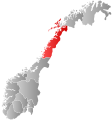Vågan
|
Vågan kommune Vuogát |
|||
|---|---|---|---|
| Municipality | |||
 |
|||
|
|||
 Vågan within Nordland |
|||
| Coordinates: 68°16′41″N 14°31′15″E / 68.27806°N 14.52083°ECoordinates: 68°16′41″N 14°31′15″E / 68.27806°N 14.52083°E | |||
| Country | Norway | ||
| County | Nordland | ||
| District | Lofoten | ||
| Administrative centre | Svolvær | ||
| Government | |||
| • Mayor (2011) | Eivind Holst (H) | ||
| Area | |||
| • Total | 477.71 km2 (184.44 sq mi) | ||
| • Land | 459.17 km2 (177.29 sq mi) | ||
| • Water | 18.54 km2 (7.16 sq mi) | ||
| Area rank | 212 in Norway | ||
| Population (2012) | |||
| • Total | 9,086 | ||
| • Rank | 115 in Norway | ||
| • Density | 19.8/km2 (51/sq mi) | ||
| • Change (10 years) | -0.9 % | ||
| Demonym(s) | Vågaværing | ||
| Time zone | CET (UTC+1) | ||
| • Summer (DST) | CEST (UTC+2) | ||
| ISO 3166 code | NO-1865 | ||
| Official language form | Neutral | ||
| Website | www |
||
|
|
|||
Vågan (Northern Sami: Vuogát) is a municipality in Nordland county, Norway. It is part of the traditional district of Lofoten. The administrative centre of the municipality is the town of Svolvær. Some of the villages in Vågan include Digermulen, Gimsøy, Gravermarka, Henningsvær, Hopen, Kabelvåg, Kleppstad, Laupstad, Liland, Skrova, Straumnes, and Sydalen.
Vågan was established as a municipality on 1 January 1838 (see formannskapsdistrikt). In 1856, the northwestern part of Vågan (population: 987) was separated to form the new municipality of Gimsøy. On 1 July 1918, the town of Svolvær (population: 2,429) was separated to form its own municipality. This left Vågan with 3,399 residents. On 1 January 1964, the municipalities of Gimsøy, Svolvær, and Vågan were merged to form the new, larger municipality of Vågan.
The municipality (originally the parish) is named after the old Vågan farm (Old Norse: Vágar), since the first church (Vågan Church) was built there. The name is the plural form of vág which means "bay". The island of Austvågøya (Old Norse: Vágøy) was named after this important site (which later led the neighboring island to be named Vestvågøya). The name was historically spelled Vaagan.
...
Wikipedia


